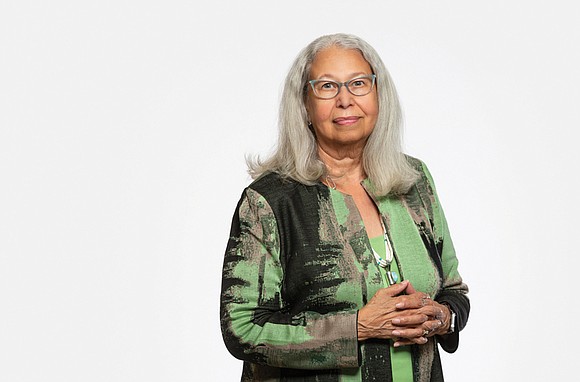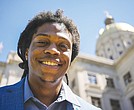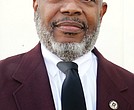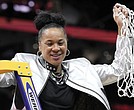Personality: Lynette Lewis Allston
Spotlight on the Virginia Museum of Fine Arts Board of Trustees president
8/25/2022, 6 p.m.
When the Virginia Museum of Fine Arts named its newest Board of Trustees president, Lynette Lewis Allston became the first Native American elected to the role in the museum’s 86- year history. The current chief and chair emeritus of the Tribal Council of the Nottoway Indian Tribe of Virginia also will be the first Native American board chair of a top 10 U.S. comprehensive art museum.
Mrs. Allston has been on the VMFA board since 2017, but her relationship with the museum started before then. More than a decade ago, she came across some information about The Studio School at VMFA in a Richmond newspaper.
“I had dabbled on and off in pottery for a while, and would occasionally take a course as a refresher or to develop a new technique,” Mrs. Allston said by phone recently. “It seemed convenient to go there even though it was a long drive, so it feels like some of what led me there was fate.”
Pottery classes are just one of many offerings at the VMFA. The museum opened in 1936, with a mission to not only collect, preserve and exhibit art, but also to encourage the study of the arts. The museum’s global collection of nearly 50,000 works of art span more than six millennia.
VMFA also offers online art education resources, visual arts workshops and performances, speaker programs and a traveling museum and art studio known as “VMFA On the Road.”
“The VMFA has been focusing on outreach with music, events, festivals and children’s activities,” Mrs. Allston said. “All these different experiences make people more comfortable going to the museum frequently. That comfort leads them to see the museum as a place for everyone,” Mrs. Allston said. While acknowledging all the museum does to reach new audiences, Mrs. Allston added “I would really like to see that outreach continue and grow.”
She believes that extended education can help the museum reach and showcase rural and Native American populations. She is excited about an upcoming “VMFA On the Road” stop Sept. 17-18 that coincides with the Nottoway Indian Tribe of Virginia PowWow at Surry Parks and Recreation Center. TheVMFA’s Arts Mobile Unit will display art that includes Native American pieces, according to the Powwow organizers. The climate-controlled 53-foot mobile unit trailer includes wi-fi to connect visitors with VMFA educators and interactive components to meet their 21st century expectations.
“It is a rural area and they are bringing a community service into a population that might not otherwise have been able to see it,” Mrs. Allston said regarding the mobile unit. “Taking the art to the people is such a special approach.”
As for showcasing indigenous culture, Mrs. Allston said the museum has recently acquired more work by Virginia’s indigenous people.
Mrs. Allston feels uniquely positioned to offer her guidance because of her Native American heritage, as well as her lifelong connection to the land. She grew up on a farm in Drewryville. Although she spent two decades in South Carolina after graduating from Duke University, she returned to the family farm with her husband of 50 years, Allard Allston.
“We met at a party and it happened that we clicked right away. When you meet the right person it’s just like that,” Mrs. Allston said. The two married 11 months later and had two sons together, Adam and Teague. Now she enjoys spending time at home relaxing whenever she can. She has a pottery studio that she likes to escape into — making functional stoneware pieces on the wheel.
“At some point in time I might just have to slow my roll,” Mrs. Allston added. “But for now, there’s never a dull moment.”
Meet a tireless advocate for educational outreach and inclusion — VMFA Board of Trustees President Lynette Lewis Allston.
Volunteer position: President, Virginia Museum of Fine Arts Board of Trustees.
Occupation: Chief, Nottoway Indian Tribe of Virginia.
Date and place of birth: December 1949 in Franklin.
Where I live now: Drewryville.
Education: Bachelor’s in history, Duke University.
Family: Husband, Allard Allston, sons Adam Allston and Teague Allston.
Virginia Museum of Fine Arts is: One of the largest comprehensive art museums in the United States. VMFA, which opened in 1936, is a state agency and privately endowed educational institution. Its purpose is to collect, preserve, exhibit and interpret art, and to encourage the study of the arts.
VMFA mission: By public mandate, the VMFA is charged with a mission to collect works of art to educate citizens throughout the Commonwealth of Virginia.
When and why founded: VMFA began in 1919 with a gift of 50 paintings from Judge John Barton Payne. Other gifts followed, and in 1932 Judge Payne proposed a $100,000 challenge grant to construct a state-operated museum for Virginia’s growing public art collection. Gov. John Garland Pollard accepted the challenge, led a campaign to raise additional funds from private donors, and promoted the idea of using state revenues for the museum’s operating expenses. Four years later, the doors of the museum’s original building opened to the public.
When elected board president: June 2022.
Length of term: Two years. Immediate past president’s name: Monroe E. Harris Jr.
Significance of being named first Native American board president in the VMFA’s 86-year history and at a top 10 U.S. Comprehensive Art Museum: It is amazing that there are still “firsts” to be achieved. As the new president, VMFA shows that it is a place for everyone. No one is excluded.
Number one goal or project as board president: I want it to be known that VMFA is a place to be enjoyed by all Virginians.
Strategy for achieving goals: The VMFA has extensive networking and supportive relationships with local museums and cultural groups across the Commonwealth.
My proudest reason to be a part of the VMFA: To be asked to serve is an honor. I suspect I am the “first” VMFA Board President who has always called a rural South Central community (Drewryville in Southampton County) “Home.” I grew up on a farm and was raised by a farm family.
How the VMFA is becoming more inviting to all people: Through art, VMFA tells the stories of people and cultures that span millennia from around the world. As this museum raises awareness and educates, it offers a view for respect and understanding though inclusion and cultural diversity.
Native American artists and the VMFA: The Native American Collection is a broad sweep that covers the Americas. Recently, more work by Virginia’s indigenous people has been acquired. Hopefully, with the expansion of gallery space, more will be added in the future.
VMFA expansion and renovation projects mean what for the entire community: The Virginia Museum of Fine Arts has begun its more than $190 million expansion and renovation project which tentatively is scheduled for completion in 2027. The project consists of adding a new wing of nearly 170,000 square feet and renovating 45,000 square feet of existing spaces, while maintaining four acres of green space in the Sculpture Garden.
COVID-19 and the VMFA: During Covid, the museum was closed for nearly four months and provided virtual programming. With the reopening, the museum followed health protocols while maintaining its commitment to education through expanded virtual engagement and the technology infrastructure that supported live programming with teachers across the state, curatorial lectures, performances by musical artists and more.
Why the VMFA never closes: Always open means VMFA is available and accessible to everyone.
Existing highlighted exhibits: Currently, “Tsherin Sherpa Spirits” is currently the featured exhibit at VMFA. Paintings and sculpture by Nepalese-born Tibetan American contemporary artist Tsherin Sherpa. The works on view address loss, struggle and re-empowerment.
Upcoming events: Opening Oct. 8 is “Storied Strings: The Guitar in American Art”. The exhibition will explore the instrument’s symbolism in American Art from the early 19th century to the present day.
How art inspires me: How art inspires me depends on my mood. Drifting through a gallery and pausing to gaze at a painting, sculpture, or digital creation connects with my feel- ings at that particular time.
A quote that inspires me: During my early years, my uncle Fitz Turner would remind me that “Excuses don’t count.” Those words were to challenge and to motivate. The message stays with me today.
At the top of my to-do list is: Next year, plant flowers like I did before the covid pandemic.
Best late-night snack: Cheese and grapes.







